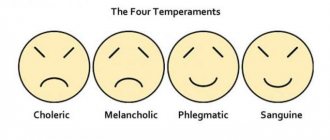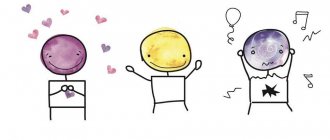The human brain is not capable of solving two problems at the same time. New technologies glorify multitasking, but research provides clear evidence that this approach reduces productivity and increases errors. Why it's better to do one thing, why we don't remember details well, and why emotional arousal is useful - T&P publishes a chapter from the book by molecular biologist John Medina, “Brain Rules. What you and your children should know about the brain,” which was published by Mann, Ivanov and Ferber.
As you read this paragraph, millions of sensory neurons in your brain light up simultaneously, trying to get your attention.
Only some of them succeed in transmitting the message to consciousness, the rest are partially or completely ignored. It's amazing how easily this balance can be maintained, effortlessly giving airtime to one of the many messages that were previously ignored. (As you read this sentence, are you aware of where your elbows are?) Attention-grabbing messages are associated with memory, interest, and consciousness. What we pay attention to often depends on memory. In everyday life, we use previous experiences to determine what to pay attention to. Different environments come with different expectations, a fact demonstrated by physical scientist Jared Diamond in his book Guns, Germs and Steel. He described a journey through the jungles of New Guinea. Compared to Westerners who have been schooled since childhood, New Guineans demonstrate very modest academic abilities. But they are by no means stupid. They are able to detect subtle changes in the jungle, which helps in tracking down a predator or finding the way home. They know which insects it is better not to touch and where to find food; they can easily build and destroy a dwelling. Diamond had never been to such places before, so he did not have the ability to pay attention to such things. The result of its testing on such tasks would be very low.
“Novel cues—unusual, unpredictable, or different—are a great way to trigger a chain reaction of attention, that is, interest.”
Culture matters, even if the physical component is not much different. For example, urban residents in Asia pay particular attention to the image of their surroundings and the relationship between objects in the foreground and background. But urban Americans do not. They pay attention to the central objects and then to the background; their sensory perception is much weaker. Such differences affect whether a business presentation or school lecture will capture the audience's attention.
Fortunately, regardless of the type of culture, all people have something in common. For example, it has long been known that interest or importance of information is inextricably linked with attention. Scientists sometimes call this connection activation. How exactly this happens still remains a mystery. Does the attention generate interest? It is common knowledge that the brain constantly scans sensory perception for potentially interesting or important events. Very important events are given special attention. But is the reverse process possible? Can attention create interest?
Marketers believe this is possible. They are well aware that new signals—unusual, unpredictable, or different—are a great way to trigger a chain reaction of attention, that is, interest. A striking example of this is the print advertisement for Sauza Conmemorativo tequila. The poster depicts an unkempt, bearded old man wearing a wide-brimmed hat, smiling to show off his only tooth. Next to it is the following inscription: “This man has only one flaw,” and below it is written in large letters: “Life is harsh. Tequila shouldn't be like this." Defying most marketing strategies aimed at a group of twenty-somethings dancing at a party, the ad was highly effective and generated public interest.
Of course, for something to attract our attention, we must understand what it is about. Can you imagine how difficult it is to study such a short-term phenomenon as attention? Scientists do not know exactly in which part of the brain the alchemical process of perception occurs. (Some evidence suggests that this process is controlled by multiple brain systems.) We have a long way to go to understand its mechanism.
The famous British neurologist and brilliant inventor, Dr. Oliver Sacks, studied perception. In the book “The Man Who Mistook His Wife for a Hat,” which became a bestseller, he described an intriguing case from his practice. One of the doctor's patients, a sweet elderly woman, intelligent, well-spoken and with a great sense of humor, suffered from a lesion in the back of her brain, which caused an unusual disorder: she could not focus her attention on things to her left. She recognized all objects in her field of vision on the right side and could apply lipstick correctly on the right side. She only ate from the right side of her plate, so she complained to the hospital staff that her portions were too small. Only after the plate was unwrapped and the food came into view to the right could she see it and continue eating.
Such cases are of great value to doctors and scientists. When a certain part of the brain is damaged, it becomes clear that behavioral deviations are associated precisely with its functioning. Studying a patient population as large as Dr. Sachs's provides an overview of which areas are involved in attentional engagement. The brain is divided into two hemispheres that perform different functions, and patients experience different disorders depending on which part is affected. Marcel Mesulam from Northwestern University discovered that there are separate centers of visual attention in the hemisphere. A small center in the left hemisphere is responsible for visual perception of objects in the visual field on the right. The global visual center is located in the right hemisphere. According to Mesulam, lesions of the left hemisphere are less critical for health, since in general it is the right hemisphere that provides visual perception.
Of course, vision is only one of the human senses. Smells and sounds are also analyzed by the brain. However, we are also aware of the internal psychological state created by various events and feelings without the specific influence of external sensory stimuli. What happens in our brain when we pay attention to something?
Thirty years ago, scientist Michael Posner developed a theory of attention that is still relevant today. Posner began his research career as a physicist at Boeing shortly after graduating from college. He made his first contribution to science by exploring the possibility of reducing the noise level of an aircraft engine to ensure passenger comfort. You can thank Posner for this, as his research now offers relative peace of mind during flight, even if the roaring turbine is just a few meters away from the passenger. Apparently, his first job aroused his interest in how the brain processes various information. He defended his doctoral dissertation based on this important problem. Posner proposed that a person pays attention to something thanks to three separate but closely interconnected brain systems, which he jokingly called the Trinity.
One fine Saturday morning, my wife and I were sitting on the terrace of our house and watching a blackbird drinking water from a special bird trough; suddenly something whistled overhead. Looking up, we saw a red-tailed owl, which flew like an arrow from a nearby tree to attack a helpless blackbird. Grabbing his prey by the throat, he began to rise upward, and drops of blackbird blood fell on our table. This end to a serene pastime was a reminder of the cruelty of the real world. We were dumbfounded.
In Posner's model, the first brain system functions like a security guard in a museum, performing two types of duties: observation and warning. The scientist calls it an alarm and activation system. It monitors the sensory aspect of normal activities. This is the overall level of attention our brain pays to the world; this state is called immanent activation. My wife and I used this system while drinking coffee and watching blackbirds. If the system detects something unusual, such as a red-tailed owl flying, it sends an alarm to the entire brain. Then the process of phase activation, that is, special attention, starts.
After the alarm, we focus on the stimulus that activated the second system. We can turn our heads towards the signal, listen, perhaps move closer or further away. That's why my wife and I stopped looking at the blackbird and turned our attention to the shadow cast by the owl. The goal of this process is to obtain more information about the stimulus so that the brain can decide how to act next. Posner calls this an orientation system.
The third system, or execution system, controls subsequent behavior. It involves prioritizing, improvising, controlling impulses, weighing the consequences of actions, or increasing attention. In my wife and I’s case, it was stunned.
Thus, we are able to recognize new signals, rush towards them and make decisions about further actions depending on the nature of the stimuli. Based on the model of brain functioning and attention proposed by Posner, a number of significant discoveries in the field of neuroscience were made, and hundreds of behavioral reactions were identified. Four of them have particular practical value: emotions, determination of meaning, multitasking and time orientation.
Events that evoke emotions are remembered better than neutral, ordinary events. This may seem obvious, but this opinion underestimates the scientific aspect, since experts are still debating what emotions are. In our opinion, it is very important to find out what impact emotions have on the learning process. An emotionally charged event (usually called an emotionally competent stimulus) is processed by the brain better than all other external stimuli. An emotionally charged event remains in the memory longer, and memories of it are clearer than ordinary incidents.
This human characteristic is effectively used in television advertising, which, of course, causes a lot of discussion. Let's look at an advertisement for the Volkswagen Passat. The video begins with two men sitting in a car, having a lively conversation about the fact that one of them constantly uses the parasitic word “as if” in his speech. The viewer then sees from the passenger window as another car suddenly appears directly in front of them. They crash into it. Screams and the sound of breaking glass are heard. The camera then shows the men being thrown around in the car and the car being crumpled. In the last frame we see men standing near a crumpled car. The paraphrased expression “Safety exists” appears on the screen. The video ends with a picture of the Passat receiving five stars in side impact crash tests. This commercial is memorable, even moving, even though it lasts only 30 seconds, because it is based on an appeal to emotions.
“Having excellent matching abilities, we are constantly looking for similarities in our environment and trying to remember what we believe we have seen before.”
But why does this work? This process involves the prefrontal cortex, the only area of the human brain that controls executive functions such as problem solving, focusing, and suppressing emotional impulses. If you imagine that the prefrontal cortex is the chairman of the board of directors, then the cingulate gyrus is her personal assistant. The assistant performs a certain filtering function and helps maintain communication with other parts of the brain - especially with the amygdala, with the help of which emotions are created and stored. The amygdala is filled with the neurotransmitter dopamine and uses it like a secretary uses sticky notes. When the brain recognizes an emotionally charged stimulus, dopamine is released, which is involved in the process of remembering and processing information, as if posting notes “Remember this!” Having received such a chemical note regarding certain information, the brain processes it more carefully. This is what every teacher, parent or advertiser strives for.
Emotionally charged stimuli can be divided into two categories: events that have individual meaning for a person, and events that are perceived equally by all people.
When my grandmother got angry (which was rarely), she would go into the kitchen and loudly wash all the dishes in the sink. If there were pots and pans among these dishes, she would deliberately knock them together as she stacked them. With this noise, she demonstrated to the entire apartment (if not the entire residential building) her frustration or dissatisfaction. To this day, at the sound of loud clanking pots and pans, I again get an emotional signal - a fleeting feeling that I am in danger. My wife, whose mother never expressed her feelings in this way, does not associate the noise of dishes with emotions. This is an example of John Medina's unique emotional stimulus.
Universal stimuli come from our evolutionary heritage and therefore have powerful potential for learning and work. It is not surprising that they closely follow Darwin's theory of the struggle for existence. Be that as it may, the brain will definitely analyze the following questions:
-Can I eat this? Could it eat me?
-Can I be friends with this? Will it be friends with me?
-Have I seen this before?
Those of our ancestors who did not remember their experiences of encountering danger or foraging for food did not live long enough to pass on their genes. The human brain has many finely tuned systems for reproduction and danger recognition. (The robbery story must have caught your attention, which is why I started this chapter with it.) With our superb matching abilities, we are constantly looking for similarities in our environment and trying to remember what we think we have seen before.
One of the best television ads used all three principles. In 1984, Steven Hayden created an advertisement for the Apple computer. The ad won all sorts of awards and set the standard for Super Bowl advertising. At the beginning of the video, we see a blue hall filled with many identically dressed people who look like robots. Flash forward to 1956 and we imagine these people watching a movie about 1984. The face of a man is shown on the full screen, from whose lips the phrases fly out: “Information cleansing!” and “Unification of thought!” The people in the room absorb these messages like zombies. The camera then pans to a girl in sportswear, holding a sledgehammer, running across the hall. She's wearing red shorts - the only splash of color in the entire video. Running down the center aisle, she throws a sledgehammer at the Big Brother screen. The screen explodes and a blinding light floods the hall. Then we see the inscription: “Apple Computer will introduce the Macintosh on January 24th - and you will understand why 1984 will not be like “1984.”
All of the above aspects are involved here. There is nothing more terrible than the totalitarian society described by George Orwell in the novel 1984. Gym shorts add a little sex appeal; however, there is another implication. It turns out Mac is a girl. So, so, so... And IBM, therefore, is a guy. In the 1980s, women gained new rights and the war of the sexes came into focus. Advertising is replete with different semantic messages. Many people have read the book “1984” or watched the movie. Moreover, computer-savvy people immediately recognized the allusion to IBM, since the company was often called the Blue Giant due to its huge sales volumes.
In advertising, it is the emotional appeal that is remembered better than other details. And there are reasons for this. The brain remembers the emotional components of an experience better than other aspects of it. It's possible to forget the small details of a minor accident, but it's easy to remember the fear you felt when trying to pull over to avoid a collision.
According to research, the emotional response focuses attention on the “gist” of the experience, discarding the details. Many scientists believe that memory tends to retain the most important things we encounter, rather than the details. Over time, the details can be restored in memory if you remember the essence. Consequently, a person’s head tends to be filled with a generalized representation of concepts or events, rather than with insignificant details that fade into oblivion. I'm sure that America's favorite game, Jeopardy! exists because we admire people who can do the reverse operation.
Of course, at work and at school, detailed knowledge is very important for success. Interestingly, you can learn to remember details based on meaning. We know this well thanks to the chance encounters between a brain scientist and a waiter in the 1980s.
Watching JC take orders is like watching Ken Jennings play Jeopardy! JC never writes anything down, but he's never made a mistake with an order. The menu offers guests over five hundred different dishes (hot appetizers, side dishes, salads, etc.), which in itself is quite impressive. The waiter takes orders from twenty people and is not mistaken even by a fraction of a percent. JC worked at a restaurant frequented by University of Colorado brain researcher Anders Ericsson. Noticing JC's unusual abilities, Ericsson asked for permission to study him. The secret of the waiter's success lay in a well-developed organization system: he always divided the customer's order into various categories, such as appetizers, temperature, side dish. And then he coded the specific order using a letter system. Blue cheese salads were designated by the letter "G", the Thousand Islands dish was designated by the letter "T", and so on. He used the same code for other dishes, and then assigned letter codes to a specific visitor and remembered them that way. The semantic hierarchy allowed him to remember details with ease.
“Whether you are a waiter or a brain scientist, if you strive for precision in detail, do not start remembering details. Focus on the key idea and build details around the main concepts."
JC's strategy is based on a principle well known to the scientific community: memory is reinforced by associations between concepts. The experiment was carried out hundreds of times, and the result was always the same: logically grouped words were remembered better than randomly presented ones, on average by 40 percent. This question fascinates scientists to this day. Including associations in data representation increases the number of objects remembered. More intellectual baggage should make learning more difficult, but research suggests the opposite. We are able to reduce the meaning of several words to one - this makes it easier for the brain to remember details. Therefore, the meaning is above the details.
John Bransford, a talented researcher and author of the best-selling book How People Learn, once wondered: What separates the novice from the expert in a particular subject? Bransford identified six characteristics, one of which relates to our question: “Knowledge (of specialists) is not simply a list of facts and formulas on a particular topic; on the contrary, they are organized around a central concept, or concept, which leads their thought to a specific area.”
Whether you're a waiter or a brain scientist, if you strive for precision in detail, don't start memorizing the details. Focus on the key idea and build details around the main concepts.
Multitasking is a myth. The brain can only focus on one thing at a time. At first glance, this is an incorrect statement: after all, some things can be done at the same time, for example, walking and talking. Or let's say the brain controls your heart rate when you read a book. Pianists play simultaneously with their right and left hands. Of course, all this applies to multitasking. But I'm talking about the brain's ability to pay attention to something. You are trying to forcefully use this resource while listening to a boring lecture at school. The same thing interferes with the flight of thought during an uninteresting presentation at work. Attention cannot be paid to different things at the same time.
I recently agreed to help a friend of my high school son's homework with homework, an experience I will never forget. Eric had been working on his laptop for about half an hour when I entered the room. He had an iPod hanging around his neck, and the voices of Tom Petty, Bob Dylan and Green Day could be heard from his headphones; With his left hand he tapped out a rhythm. At least eleven windows were open on the screen, in two of them there was active correspondence with friends from the MySpace network. In another window, an image from Google was loading. In the background of the window was an image that Eric was redoing for a friend on MySpace, and in another, a paused tennis video game.
Somewhere in the midst of all these tasks, a word processing program was launched containing a document for which my assistance was needed. “Music helps me concentrate,” Eric said while talking on his cell phone. “I’m doing fine at school, I’m just stuck.” Thank you for coming". He's really stuck. Eric read a sentence or two, then started typing a message into MySpace, then checked to see if the download was finished, and then went back to work. Of course, he was not focused on the task. Does he remind you of someone you know?
Research has put an end to this debate by proving that humans are not capable of multitasking. The brain is not designed to process multiple attention-demanding signals simultaneously. Eric, like the rest of us, simply jumped from one thing to another. To understand this, we need to study the third component of Posner's Trinity - the execution system. Let's look at how it works for Eric when he is trying to work on a task and this process is interrupted by the message “You have received an email!” from his girlfriend Emily.
Definition
In twentieth-century psychology there are several main schools of psychology. Therefore, the definition of emotional arousal may vary.
Behaviorism or pragmatic psychology
This school was founded by D. Watson. Its main idea is that a person at birth has only 3 instincts - sexual, fear and rage. The remaining emotions that appear are only a conditional acquired version of the main instincts.
Emotional excitability in behaviorism is a reaction to the influence of external stimuli that appears throughout a person’s life.
Gestalt psychology and emotional excitability
Excitability in psychology, according to Gestalt supporters, is accumulated energy that allows you to change the distance when in contact with the outside world. Emotional excitability is considered a complex emotion, which consists of several simple ones.
This is fear and anger. These two emotions reach their toxic state when a person is no longer able to control himself. Rage and rage appear.
Emotional excitability and psychoanalysis
The founder of psychoanalysis is Sigmund Freud. According to followers of Freudianism, human consciousness is not the limit of our psyche. Most of human emotions are hidden in the unconscious part.
Emotional excitability is one of the unconscious reactions of a person to environmental influences. A person can cope with some manifestations of emotions on his own, but when excitability reaches its peak, psychoanalysis will help the person cope. He will answer the question of where emotions such as rage and anger came from.
Humanistic psychology
The principles of humanistic psychology are acceptance and love for each individual person. The motto of supporters of humanistic psychology is “Psychology for man, not man for psychology.”
The founders of the humanistic school are Abraham Maslow and Carl Rogers. Emotional excitability, in their opinion, is only a person’s defensive reaction, which appears due to fear. This is where tough behavior and aggressiveness comes from.
Emotional excitability in psychology
It is also worth remembering that in humanistic psychology, each emotion is unique to each person. The same condition can occur in completely different ways in people. Supporters of humanism believe that goodness and tranquility can be “pulled” out of every person by providing him with an atmosphere of security.
Treatment for emotional illness
Treatment for emotional excitability should be started immediately. Moreover, it does not include supernatural procedures that cost hundreds of thousands of dollars.
So, first of all, you need to establish contact with the “patient” so that he can completely trust you.
A person facing this problem must also be prescribed the correct diet. It is necessary to exclude products that contain caffeine. You cannot watch films and TV shows with elements of violence and cruelty. This may make the situation worse. It is necessary to provide the most comfortable place to sleep and constantly ventilate the room in which a person with emotional excitability is located. The scale of this problem can be so high that it is better not to leave him alone. It is unknown when the next attack will occur.
It’s rare, but there are cases when a doctor prescribes sleeping pills so that a person can relax and get a good night’s sleep.
Kinds
Excitability in psychology is divided into 2 options – low and high.
High
In psychology, excitability is an instant reaction to an external stimulus. From a state of rest, a person instantly moves into a state of active emotion. These emotions include anger, rage, intense joy, and fear.
The person’s condition at this moment may not be entirely adequate. A person at such a moment cannot reasonably assess the situation; he is overly impulsive, sometimes aggressive. Increased emotional excitability often becomes an obstacle to building healthy interpersonal relationships.
But it is worth noting that with increased emotional excitability, a person “flashes up” almost instantly to any type of influence from the environment, and also quickly “cools down”.
People with increased emotional excitability can be described as hot-tempered and restless. A person is often in a state of irritation. Moreover, most often the source of irritation does not correspond to the strength of the reaction that manifests itself in a person.
This type of people is also characterized by low team spirit and conflict, where they will be the provoking party.
In a calm state, a person is absolutely adequate. He is friendly and makes contact. But he quickly loses his temper.
Such people often fall into the Karpman triangle. “Emotional swings” during the period of active reaction make a person an “executioner,” or in other words, an abuser. The executioner puts emotional pressure on the second person, humiliates, and carries out psychological violence. Then the transition to reducing the reaction occurs. And the person already becomes a victim.
He feels fear and anxiety. Therefore, he begins to feel sorry for himself, blaming other people for his inappropriate behavior. The second person can act as a rescuer. He will try to pull the person out of an aggressive state. Roles can change between two people. Also, all 3 roles can be in one person’s head.
Low
The second type is characterized by reactions opposite to the first type. Most often, phlegmatic people are people with reduced emotional excitability. The chain of occurrence of a reaction stretches for a very long time. People with reduced emotional excitability are considered cold-blooded.
But, if in the first type of excitability, people quickly moved into a state of emotional reaction, and also quickly calmed down. Then, with reduced emotional excitability, a person takes a long time to switch to an active reaction. But it is also difficult for him to quickly “cool down” from his emotions.
Prevention and treatment
To avoid the occurrence of nervous system excitability syndrome, you should follow several tips:
- Normalize your sleep schedule. The body needs proper rest and should go to bed at a certain time and sleep at least 8 hours a day.
- Avoid stress and eliminate negative factors. Sit less at the computer or TV, and walk more in the fresh air
- Try to diversify your leisure time with yoga, aerobics or any other sport, do gymnastics. Good for the body and soul.
- Take relaxing baths. Essential oils and decoctions of chamomile, thyme, juniper, lemon balm and valerian root will help restore mental and physical balance. And good for the skin!
- Replace coffee, black and green tea with herbal teas. The same lemon balm, chamomile, mint and motherwort will help calm the nervous system, normalize sleep and remove toxins.
- Practice breathing exercises and meditation. Helps you learn to control your emotions.
By following these simple tips, you can control your emotions and avoid the unpleasant experience of increased emotional excitability.
Be healthy!
Characteristics and properties
Increased excitability has the main characteristics in psychology:
- This is the rapid occurrence of an active reaction.
- The same rapid decay of the reaction.
- Great intensity of experience.
- The expression of one's emotions is very violent (excessive aggression, fear, uncontrollable anxiety, unbridled joy).
- Lack of conscious control at the time of active reaction. A person stops consciously looking at the situation and acts “on emotions.”
- Attention is focused only on the source of irritation, on what provokes the occurrence of an emotional reaction.
- The ability to switch attention decreases.
- After the reaction “fades away,” the person feels tired, lacks strength, and often feels remorse.
Reduced emotional excitability has the following characteristics:
- The reaction to external stimuli occurs very slowly, sometimes not at all.
- Detachment of a person from society.
- Deep experience of emotion, if it arises.
- Long-term attenuation of the reaction (a person moves away from his experiences for a long time).
Such reactions in psychology are called affectivity. According to V. Witwicki (founder of the theory of kratism), affectivity is a sensory state of a person in which his emotions acquire significant strength, thereby disrupting mental life. A.G. Fortunatov (a Soviet psychologist who studies emotional reactions) called emotion a slight excitement, and affectivity a storm.
Forms of manifestations
Excitability is the following manifestations in psychology:
- The person is often irritated.
- Reduced performance, due to the fact that a person focuses on the source of irritation, attentiveness decreases.
- Among the physical manifestations, muscle spasms are observed. Most often these are the muscles of the shoulder complex and the muscles of the face. Muscle spasms occur due to the fact that a person is often tense.
- Low contact with the outside world. It is difficult for a person to adapt to society, since he is a provocateur of groundless conflicts.
How low excitability manifests itself:
- Lack of response to stimulus.
- Withdrawal from society.
Reduced emotional excitability does not mean that a person cannot fall into a state of rage or anger. The difference is that in a person with reduced activation of the reaction, the process from a state of rest to a “storm of emotions” is slow. But at the same time, the reaction may take a long time.
Is hospitalization necessary?
It is necessary to hospitalize a person who suffers from emotional excitability only after the doctor has taken all possible measures to treat him and has not noticed a single result. Then hospitalization in the psychiatry department is necessary.
Patients who pose a threat to both their lives and the lives of others require special attention. And people whose relatives received a message that their loved one needs hospitalization.
Diagnostics
Representative of Soviet psychology Smirnov B.N. developed a method for determining the level of excitability called “Emotional excitability - balance.”
In order to find out the level of excitability, you need to answer the test questions with monosyllabic answers - yes or no. The test contains 15 questions with which you can find out how often a person feels guilty, how often he feels irritated, and what kind of relationship he has with the world around him.
The results of the test are a scale from 0 to 20 points, where 0-3 points are very low excitability, 8-13 are average excitability, 18-20 points are very high excitability.
The second indicator in the test is sincerity. It is assessed on a scale from 0 to 8 points. If sincerity is 7 or less, then the probability of a correct diagnosis will be low.
Psychological theories
There are basic psychological theories of human emotions. The main ones are described below.
Evolutionary theory
This theory was created by Charles Darwin. Its meaning is that emotions are vital human mechanisms. With their help, the body adapts to various situations in life.
Rudimentary Theory of Emotions
The second theory of emotions appeared after the evolutionary theory. Proponents of positivism call emotions an “echo” of the instinctive “fight-flight-freeze” reaction of animal ancestors.
That is, a person’s aggressive behavior, characterized by active movement of the arms and raising the voice, is a reference to the “hit” instinct. A person feels fear for himself, the brain tries to protect the body and gives such a reaction. Fear can also be reflected by numbness, which can be described as “freezing.”
Psychoanalytic theory
This theory belongs to supporters of Freudianism. Despite the fact that the theory has little agreement with the general idea of the organization of brain activity, it has attracted the interest of many scientists. The meaning of the theory is that emotions are an unconscious excess of energy, which is due to the fact that some conflict situation has been deposited in the consciousness and fixed at the level of instincts.
Cannon-Bard theory of emotion
The Cannon-Bard theory shows that emotions are inextricably linked with a person’s physical state. When an event occurs that causes an experience, nerve impulses go to the thalamus, and from there they go to the cerebral cortex and the hypothalamus.
On the one hand, it causes emotional feelings such as fear, anxiety or anger. On the other hand, it causes physiological changes such as increased heart rate, sweating, and dizziness.
Cognitive dissonance theory
The theory of Leon Festinger, an American psychologist, is that there are two types of emotions - positive and negative. These emotions are inextricably linked with the impact on the outside world. Positive emotions, such as joy, appear at the moment when a person’s planned action plan is implemented without obstacles.
Negative emotions appear when expectations and reality do not match. This theory slightly narrows the concept of emotions, without showing their versatility, but shows the dependence of the emotional state on the implementation of planned actions.
Management methods
Excitability is a state in psychology that is well corrected by self-regulation. The objectives of this method are to reduce the manifestation of stressful perceptions, reduce emotional tension, and concentrate attention.
The main task of a person with increased emotional excitability is to realize that such a condition is becoming a problem. It prevents you from living fully, developing and interacting with the world around you. After a person realizes his problem, he has a sincere desire to change the situation.
Psychological self-regulation is divided into several types:
- Neuromuscular relaxation.
- Ideomotor training.
- Sensory reproduction of images.
- Autogenic training.
Methods of influencing the emotional state can be used both in combination and separately.
The first method arose after the research of the American psychiatrist E. Jacobson. Back in the twentieth century, he identified a connection between a negative emotional state and skeletal muscles.
The method focuses on alternately tensing and relaxing individual muscle groups. The stage of muscle relaxation can be compared to a feeling of warmth, a feeling that occurs during rest. This effect causes psychological relaxation.
The technique must be learned gradually.
The training takes place in several stages:
- Learning the skill of relaxing individual muscle groups at rest.
- Combining the skills acquired after 1 point into one complex, which allows you to relax the entire body, or individual muscle groups, both while in a state and while performing any actions. Moreover, muscles that are not involved in movement relax.
- The last stage is considered to be “relaxation skill”. He will teach you how to get a release even in tense situations.
Training takes from 20 minutes. up to 1 hour, depending on how many approaches are performed for each point. During each session, different parts of the body are tensed and relaxed alternately (limbs, torso, face, shoulders, etc.).
The second method is similar to neuromuscular relaxation, but the main difference is that the tension-rest process does not actually occur. You need to imagine this process in your head.
The veracity of this method is proven by the research of the famous physiologist I.P. Pavlova. The fact is that the strength of human muscle activity when mentally starting a movement is exactly the same as during a real movement.
Sensory reproduction of images lies in the fact that at the moment of emotional arousal it is necessary to imagine objects of rest and relaxation. You need to reproduce situations and people in your head that may be associated with your vacation.
For example, you need to imagine yourself sitting in a comfortable position in the forest.
Meditation has a similar method of influence. But meditations are aimed at deeper immersion and relaxation. During meditation, you focus on your inner world, on the rhythm of your breathing. Autogenic training can be called self-hypnosis.
Such training is divided into several types:
- According to Schultz's method. This type of training involves focusing attention on a specific part of the body. For example, you need to think that your left leg is heavy. With the help of regular training, you can notice that over time there will actually be a feeling of heaviness in the limb.
- A.I. Nekrasov developed a technique that acts in 6 directions. These influences are heaviness, warmth, breathing, heart, stomach, forehead. With the help of autosuggestion, you need to concentrate your attention first, making the body heavy, then creating a feeling of warmth. Gradually the lesson turns into focusing on breathing. Then you should concentrate on the heart, stomach and move to the forehead. The lesson includes several repetitions of the exercise.
Excitability lends itself well to methods of psychological self-regulation. Most of these methods can be implemented independently, but it will be more effective to work through your problems with a psychologist.
Description of emotional disturbance
The main characteristics of such a disease are negative emotions that accompany a person everywhere, regardless of the situation. He is insecure, closed, hostile and suicidal. For these reasons, such a person cannot be left alone.
A person suffering from such emotional disorders is not aware of the risk and danger, and therefore can harm himself and the people around him. Diagnosis of the disorder is possible only at a conscious age. Since a child’s behavior can be justified by misunderstanding and immaturity. Adults mistakenly mistake a disorder in a child’s psyche for the norm, believing that this is a trait of a developing character.
Often, a person with such a disorder loses orientation in space. The symmetry of his face may be disturbed, his eyes are difficult to hold at one point, and muscle twitching in the eye area may be periodically noticeable.








